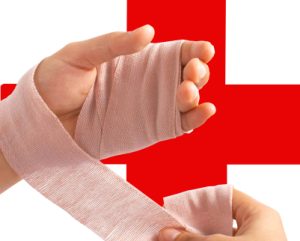The management of wounds is a critical aspect of healthcare that requires a comprehensive approach involving multiple disciplines and the latest in care techniques. This article explores the various dimensions of wound care management, from the basics of treatment to the collaborative efforts needed to optimize healing and patient involvement.
Key Takeaways

Case Managers can help coordinate healthcare teams and ensure proper upkeep and follow up care is given to the patient’s wound.
- Understanding the fundamentals of wound care is essential for effective management and resource optimization.
- Interdisciplinary collaboration and the use of cutting-edge technology are key to improving healing rates and patient quality of life.
- Regular training and the establishment of best practices are crucial for ensuring high-quality wound care.
- Patient involvement and education in wound care can significantly enhance treatment outcomes and prevent complications.
- Advancements in wound care research and technology continue to evolve, offering new opportunities for more effective treatments.
Overview of Basic Wound Care Management
Understanding the Fundamentals
Basic wound care management is essential for effective patient recovery and prevention of complications. Proper understanding of wound healing processes—such as hemostasis, inflammation, and epithelialization—is crucial. This knowledge ensures that healthcare providers can apply the most appropriate and effective treatments.
Resource Utilization
Effective wound care management requires significant resources. It involves not only the direct care of wounds but also the strategic use of materials and personnel to optimize healing and minimize resource waste. Strategies include streamlining the supply chain for dressing materials and educating staff on the latest wound care techniques.
Improving Healing Rates
To enhance the healing rates of wounds, it is imperative to implement evidence-based practices. These include maintaining a clean and moist wound environment, using advanced dressings, and employing modern therapeutic techniques. Regular monitoring and timely interventions can significantly improve outcomes and reduce the duration of patient recovery.
Collaborative Approaches in Wound Management
Case Managers help coordinate healthcare teams in providing the best care for the wound of the patient.
Interdisciplinary Team Roles
In effective wound management, the collaboration between various healthcare professionals is crucial. The nursing team, treating medical team, and specialists such as stomal therapists and plastic surgeons play pivotal roles. Each member contributes uniquely to the management and dressing selection, optimizing the healing process.
Referral Processes
Referrals are essential for specialized wound care. They should be streamlined through an Electronic Medical Record (EMR) system to ensure timely and appropriate management. This process involves multiple healthcare departments, including Specialist Clinics and Allied Health teams.
Optimizing Dressing Selection
Selecting the right dressing is a critical decision that affects wound healing. It requires a thorough understanding of wound types and the available dressing technologies. The choice of dressing can significantly influence the healing rate and should be made collaboratively by the interdisciplinary team.
Healing Mechanisms in Wound Care
Primary Intention
Wound healing through primary intention involves the direct closure of the wound, typically through surgical means such as suturing or stapling. This method is most effective for clean, uninfected wounds with well-defined edges. The goal is to minimize scarring and reduce the risk of infection, promoting a quicker recovery.
Monitoring Progress
Effective wound management requires diligent monitoring to assess the healing process. Key indicators include the reduction of redness and swelling, the absence of infection, and the progression of tissue regeneration. Regular assessments help in adapting the treatment plan to enhance healing outcomes.
Adapting Care Plans
Adapting care plans to individual needs is crucial for optimal healing. Factors such as the patient’s nutritional status, underlying health conditions, and mobility affect wound healing. Tailored interventions, considering these intrinsic and systemic factors, are essential for effective wound management.
Implementing Wound Assessment Technology
Role in Pediatric Care
The implementation of wound assessment technology plays a crucial role in pediatric care, enhancing the accuracy and efficiency of treatments. These technologies, particularly portable imaging devices, allow for precise measurements and monitoring of wound healing, which is vital in the sensitive and varying physiology of children.
Guidelines and Aims
Wound assessment technology aims to standardize the evaluation process across different healthcare settings. Guidelines focus on ensuring consistent and accurate measurements, which are critical for effective treatment planning and outcome prediction.
Multidisciplinary Assessment
Incorporating technology into wound care facilitates a multidisciplinary approach, involving various healthcare professionals. This integration ensures comprehensive care, from initial assessment to the final stages of healing, leveraging the expertise of each team member.
Defining Key Terms in Wound Care
Common Definitions
In the realm of wound care, understanding the terminology is crucial for effective communication and treatment planning. Key terms include ‘acute wound’, ‘chronic wound’, ‘debridement’, and ‘exudate’ among others. These terms help in categorizing and treating wounds based on their nature and severity.
Impact of Comorbidities
Comorbidities significantly affect wound healing processes. Conditions such as diabetes and vascular diseases can impede blood flow, thus delaying wound healing. It’s essential to consider these factors when planning treatment to ensure optimal care.
Preventive Measures
Preventive strategies in wound care are vital to reduce the incidence of wounds, especially in at-risk populations. These include regular inspections, maintaining skin moisture, and proper nutrition. Implementing these measures can significantly decrease the risk of wound development and complications.
Assessing Causes of Wounds
Identifying Damage
Identifying the cause and extent of damage is crucial for effective wound management. Early and accurate assessment helps in tailoring the treatment to the specific needs of the wound, thereby enhancing the healing process. Factors to consider include the size, depth, and the presence of any foreign bodies or underlying tissue damage.
Control Measures
Control measures are essential to prevent the exacerbation of the wound. These include maintaining a stable temperature and moisture balance, ensuring adequate oxygenation, and managing any infection present. It is also important to address any intrinsic factors such as nutrition and underlying chronic diseases that may affect wound healing.
Predicting Treatment Outcomes
Predicting treatment outcomes involves understanding the complexities of wound healing and the patient’s overall health status. This includes monitoring the wound’s response to treatment and making necessary adjustments to care plans. Effective prediction helps in setting realistic expectations and improving patient outcomes.
Note: Effective wound assessment and management require a comprehensive understanding of both the wound and the patient’s overall health condition.
Establishing Best Practices Internally
Training Staff
Ensuring that all healthcare providers are well-trained in the latest wound care techniques is crucial. Comprehensive education programs should be established, focusing on both theoretical knowledge and practical skills. Workshops and continuous training sessions can help in maintaining high standards of care.
Partnering with Specialists
Collaboration with specialists in wound care enhances the overall quality of care provided to patients. Establishing partnerships with experts can bring in advanced insights and techniques, thus improving patient outcomes.
Ensuring Proper Techniques
Adopting and adhering to evidence-based practices is essential for consistent patient care. Regular audits and feedback mechanisms should be implemented to ensure that the care provided meets the highest standards. The use of innovative technologies, such as portable wound assessment devices, can aid in early detection and management of wound conditions, thus enhancing the effectiveness of treatments.
Role of Post-Acute Professionals

Case Management plays a key role in record keeping and assessment of healing.
Improving Patient Quality of Life
Post-acute professionals are pivotal in enhancing patient outcomes by teaching management skills that foster independence and self-care. Their role extends to ensuring that patients are well-equipped with the necessary knowledge and tools to manage their conditions effectively, which significantly contributes to improved quality of life and reduced complications.
Teaching Management Skills
The education imparted by these professionals is crucial for patient empowerment. By providing comprehensive training and resources, they help patients understand their treatment protocols, which aids in faster recovery and minimizes the risk of rehospitalization.
Recognizing Complications Early
Early detection of complications is vital in post-acute care. Through regular monitoring and assessments, post-acute professionals can swiftly intervene, preventing the escalation of potential issues. This proactive approach not only saves costs but also enhances the overall healing process.
Challenges in Wound Care Management
Dealing with Complications
In the realm of wound care, complications can arise from a variety of sources, including infections, delayed healing, and reactions to treatment methods. Effective management of these complications is crucial to prevent prolonged recovery times and increased healthcare costs. Strategies to address these issues include rigorous monitoring, timely intervention, and personalized care plans based on individual patient needs.
Generalized Treatment Risks
The application of generalized treatment protocols to all patients can lead to suboptimal outcomes. Each wound and patient is unique, and treatments must be tailored to address specific conditions and comorbidities. This approach helps in minimizing risks associated with inappropriate treatment applications and enhances the overall effectiveness of wound care strategies.
Implementing New Methods
Introducing new wound care techniques and products into clinical practice involves challenges related to acceptance, training, and evaluation of effectiveness. It is essential to ensure that these new methods are implemented with careful oversight to avoid potential setbacks. Continuous education and training for healthcare providers are vital to keep up with advancements and to ensure the safe integration of innovative treatments into standard care practices.
Advancements in Wound Care Techniques
Research and Development
The field of wound care is rapidly evolving with significant investments in research and development. Innovations such as xenogeneic tissue scaffolds and recombinant growth factors are transforming patient outcomes. These advancements are crucial for enhancing the efficacy of wound treatments and reducing recovery times.
Updating Clinical Practices
As new technologies and treatments emerge, updating clinical practices is essential. This includes integrating novel methods like endoscopic subfascial ligation and endovascular arterial repair techniques into standard care protocols to ensure that all healthcare providers are up-to-date with the latest in wound care management.
Cooperation with Specialized Facilities
To maximize the benefits of new wound care technologies, cooperation with specialized facilities is vital. These collaborations help in refining techniques such as negative pressure wound therapy and optimizing the use of advanced dressings and devices. By working together, healthcare providers can leverage collective expertise to improve patient care and outcomes.
Patient Involvement in Wound Care

Self-Management Education
Empowering patients through education is crucial for effective wound care management. Providing patients with the knowledge and skills to manage their wounds can lead to improved outcomes and a greater sense of control over their health. Educational sessions should cover topics such as proper wound cleaning, the importance of maintaining a clean environment, and recognizing signs of infection.
Tools for Effective Care
To support patients in their self-management, various tools and resources should be made available. These include instructional guides, videos, and wound care kits. Ensuring that patients and caregivers know the correct technique to use, these materials should be made available as options. Regular updates and easy access to these resources can significantly enhance patient autonomy and treatment effectiveness.
Benefits of Active Participation
Active participation in wound care not only improves healing rates but also enhances the patient’s quality of life. When patients are involved in their care, they are more likely to adhere to treatment plans and engage in preventive measures. This involvement can also lead to quicker recognition of complications, which is crucial for timely intervention and improved outcomes.
Resource Management in Wound Care
Reducing Hospital Stays
Effective resource management in wound care is crucial for reducing hospital stays. By optimizing wound care protocols and streamlining processes, healthcare facilities can minimize the duration of inpatient care required for wound management. This not only frees up hospital resources but also enhances patient comfort and recovery speed.
Preventing Infections
Preventing infections is a pivotal aspect of resource management in wound care. Implementing stringent sterilization and hygiene practices can significantly reduce the incidence of wound-related infections, thereby conserving resources and improving patient outcomes.
Cost-Effective Strategies
To ensure sustainability in wound care, adopting cost-effective strategies is essential. This involves evaluating and selecting appropriate wound care products and technologies that offer the best value for money. Additionally, training healthcare providers on efficient resource utilization can lead to substantial cost savings and improved care quality.
By focusing on efficient resource management, healthcare facilities can enhance the overall effectiveness of wound care, leading to better patient outcomes and reduced costs.
Conclusion

In conclusion, effective case and wound management of patients is a multifaceted endeavor that requires a collaborative and systematic approach. It is essential to integrate the latest research, technology, and best practices to optimize wound healing and patient outcomes. By fostering cooperation among healthcare professionals and ensuring they are well-informed and equipped, we can enhance the quality of care provided to patients. Additionally, involving patients in their own care and educating them on proper wound management techniques can significantly reduce complications and improve healing rates. Ultimately, a comprehensive and evidence-based approach to wound care management not only benefits individual patient health but also contributes to the overall efficiency and effectiveness of healthcare facilities.
Please also review AIHCP’s Case Management Certification and see if it meets your academic and professional goals. The program is online and independent study and open to qualified professionals seeking a Case Management Certification
To learn more about AIHCP’s Nurse Patient Educator Certification then please also review the program and see if it meets your academic and professional goals.
Frequently Asked Questions
What is primary intention in wound healing?
Primary intention refers to a method of wound healing where the wound edges can be pulled together, such as in a surgical incision, using sutures, staples, or steristrips.
How can resource utilization improve basic wound care management?
Effective resource utilization in wound care can reduce follow-up visits and lengthy hospital stays due to infections, optimizing the overall healthcare facility’s operations.
What role do post-acute professionals play in wound care?
Post-acute professionals improve patient quality of life by teaching proper wound care management skills, helping in quicker recognition of complications, and enhancing treatment outcomes.
What is the aim of implementing wound assessment technology in pediatric care?
The aim is to provide guidelines for assessing and managing wounds in pediatric patients, ensuring optimal healing through ongoing multidisciplinary assessments and interventions.
How does understanding comorbidities impact wound care management?
Knowing the impact of comorbidities, such as diabetes, on wound healing helps providers avoid complications and improve healing speeds by tailoring treatments to individual needs.
What are the risks associated with generalized wound care treatment?
Generalized treatment can lead to assumptions and risks, necessitating careful implementation of new methods and oversight to avoid complications.
How does assessing the cause of wounds aid in management?
By identifying the cause and extent of damage, providers can apply targeted control measures and predict treatment outcomes more accurately.
What are the benefits of involving patients in wound care?
Involving patients in their wound care through education and tools empowers them, leading to active participation and potentially better healing outcomes.
Additional Resources
Hogan, T. (1997). “Case management in a wound care program”. 1997 Jan-Feb;2(1):2-13; quiz 14-5. National Library of Medicine. Access here
Bowers, S & Franco, E. (2020). “Chronic Wounds: Evaluation and Management”. Am Fam Physician. 2020;101(3):159-166. American Family Physician. Access here
“Creating a Plan of Care for Wound Management” (2022). Wound Source. Access here
Annesley, S. (2019). “Current thinking on caring for patients with a wound: a practical approach”. British Journal of Nursing. Access here
